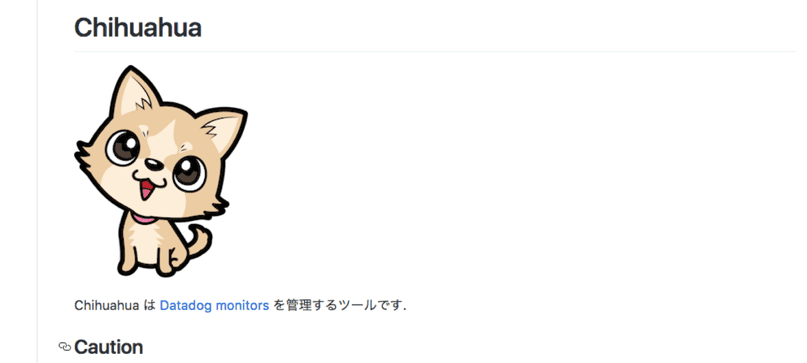
- tl;dr
- 作ったもの
- 使い方
— インストール
— 初期化
— 既存設定の書き出し
— 新規登録
— 更新
— 削除 - ということで
— Datadog API の Monitors Tips
— 想定する使い方
— codenize-tools
tl;dr
既に Datadog の Monitors を管理するコマンドラインツールとして codenize-tools の Barkdog が有名で、他の codenize-tools ツール達と同じインターフェースで備えていて、ちゃんと使うなら Barkdog だなーと思っている。
github.com
しかし、朝、目が覚めて、何かが降りてきたのか知らないけど、Monitors の API 周りの勉強を兼ねて、自分でもコマンドラインツールを作ってみることにした。
作ったもの
チワワ。
github.com
詳細は README を。
使い方
インストール
Gem では今のところ配布していない。
git clone https://github.com/inokappa/chihuahua.git cd chihuahua bundle install --path vendor/bundle
初期化
Monitors の定義を書き出すディレクトリを作成する。
bash-3.2$ bundle exec ./bin/chihuahua init done. bash-3.2$ tree monitors/ monitors/ 0 directories, 0 files
上記のように monitors ディレクトリが作成されているはず。
既存設定の書き出し
チワワは既存設定の書き出しから始めることを想定している。また、必ず --project= オプションでプロジェクト名を指定する必要がある。これは、一つの Datadog アカウントに複数のプロジェクトの Monitors 設定が行われている場合、Monitors の Name キーや Tags キーによってプロジェクトを絞り込んで利用することを想定している。
export DATADOG_API_KEY=... export DATADOG_APP_KEY=... bundle exec ./bin/chihuahua export --project=your_project_name --tags=project:foo,stage:production
上記のように--tags= オプションでタグを指定することで、任意の Monitors 定義を取得することが出来る。export オプションで書き出しを行うと以下のように monitors ディレクトリ以下にプロジェクト名のディレクトリが作成されて monitors.yml ファイルが作成されている。
$ bundle exec ./bin/chihuahua export --project=foo --tags=host:vagrant-ubuntu-trusty-64
Export...
6 monitors output done.
$ tree -a ./monitors/
./monitors/
└── foo
├── .filter.yml
└── monitors.yml
1 directory, 2 files
新規登録
書き出された既存の Monitors 定義を利用して新しい Monitors 定義を登録してみる。
$ vim ./monitors/foo/monitors.yml
#
# 以下を追加
#
- query: avg(last_1m):avg:system.load.5{host:vagrant-ubuntu-trusty-64} > 1
message: |-
CPU load is very high on {{host.name}}
@slack-datadog-notification
name: Test 10 [{{#is_alert}}CRITICAL{{/is_alert}}{{#is_warning}}WARNING{{/is_warning}}]
CPU load is very high on {{host.name}}
type: metric alert
options:
thresholds:
critical: 1.0
warning: 0.8
上記のように monitors.yml に定義を追加する。ポイントは id キーを付与しないこと。
以下のように --dry-run オプションを付けて chihuahua export を実行すると、一応 登録する内容のチェックを行うことが出来る。
$ bundle exec ./bin/chihuahua apply --project=foo --dry-run
Apply...(dry-run)
Check add line.
---
query: avg(last_1m):avg:system.load.5{host:vagrant-ubuntu-trusty-64} > 1
message: |-
CPU load is very high on {{host.name}}
@slack-datadog-notification
name: Test 10 [{{#is_alert}}CRITICAL{{/is_alert}}{{#is_warning}}WARNING{{/is_warning}}]
CPU load is very high on {{host.name}}
type: metric alert
options:
thresholds:
critical: 1.0
warning: 0.8
定義する内容に問題なさ気であれば、--dry-run を外して登録する。
$ bundle exec ./bin/chihuahua apply --project=foo
Apply...
Add line.
{"tags"=>[], "deleted"=>nil, "query"=>"avg(last_1m):avg:system.load.5{host:vagrant-ubuntu-trusty-64} > 1", "message"=>"CPU load is very high on {{host.name}}\n@slack-datadog-notification", "id"=>1234567, "multi"=>false, "name"=>"Test 10 [{{#is_alert}}CRITICAL{{/is_alert}}{{#is_warning}}WARNING{{/is_warning}}] CPU load is very high on {{host.name}}", "created"=>"2017-03-11T13:01:57.454395+00:00", "created_at"=>1489237317000, "creator"=>{"id"=>22222, "handle"=>"inokara@gmail.com", "name"=>"ようへい かわはら", "email"=>"inokara@xxx.com"}, "org_id"=>11111, "modified"=>"2017-03-11T13:01:57.454395+00:00", "overall_state_modified"=>nil, "overall_state"=>"No Data", "type"=>"metric alert", "options"=>{"notify_audit"=>false, "locked"=>false, "silenced"=>{}, "thresholds"=>{"critical"=>1.0, "warning"=>0.8}, "new_host_delay"=>300, "require_full_window"=>true, "notify_no_data"=>false}}
更新
定義を少し更新してみる。
$ vim ./monitors/foo/monitors.yml
#
# query と thresholds を更新してみる
#
- query: avg(last_1m):avg:system.load.5{host:vagrant-ubuntu-trusty-64} > 2
message: |-
CPU load is very high on {{host.name}}
@slack-datadog-notification
id: 1234567
name: Test 10 [{{#is_alert}}CRITICAL{{/is_alert}}{{#is_warning}}WARNING{{/is_warning}}]
CPU load is very high on {{host.name}}
type: metric alert
options:
thresholds:
critical: 2.0
warning: 0.8
以下のように --dry-run オプションを付けて chihuahua exportを実行すると、一応登録する内容のチェックを行うことが出来る。
$ bundle exec ./bin/chihuahua apply --project=foo --dry-run
Apply...(dry-run)
Check update line.
---
tags: []
-query: avg(last_1m):avg:system.load.5{host:vagrant-ubuntu-trusty-64} > 1
+query: avg(last_1m):avg:system.load.5{host:vagrant-ubuntu-trusty-64} > 2
message: |-
CPU load is very high on {{host.name}}
@slack-datadog-notification
id: 1234567
name: Test 10 [{{#is_alert}}CRITICAL{{/is_alert}}{{#is_warning}}WARNING{{/is_warning}}]
CPU load is very high on {{host.name}}
type: metric alert
options:
notify_audit: false
locked: false
silenced: {}
thresholds:
- critical: 1.0
+ critical: 2.0
warning: 0.8
new_host_delay: 300
require_full_window: true
notify_no_data: false
done.
定義する内容に問題なさ毛であれば、--dry-run を外して登録する。
$ bundle exec ./bin/chihuahua apply --project=foo
Apply...
Update line.
{"tags"=>[], "deleted"=>nil, "query"=>"avg(last_1m):avg:system.load.5{host:vagrant-ubuntu-trusty-64} > 2", "message"=>"CPU load is very high on {{host.name}}\n@slack-datadog-notification", "id"=>1234567, "multi"=>false, "name"=>"Test 10 [{{#is_alert}}CRITICAL{{/is_alert}}{{#is_warning}}WARNING{{/is_warning}}] CPU load is very high on {{host.name}}", "created"=>"2017-03-11T13:01:57.454395+00:00", "created_at"=>1489237317000, "org_id"=>11111, "modified"=>"2017-03-11T13:08:16.046036+00:00", "overall_state_modified"=>nil, "overall_state"=>"No Data", "type"=>"metric alert", "options"=>{"notify_audit"=>false, "locked"=>false, "silenced"=>{}, "thresholds"=>{"critical"=>2.0, "warning"=>0.8}, "require_full_window"=>true, "new_host_delay"=>300, "notify_no_data"=>false}}
done.
削除
って怖いのでダッシュボード上で指差し確認しながら削除する想定なので、削除は実装していない(というか出来ない。スキル的に)。ダッシュボードで削除した上で書き出しを行えば、一応、定義をコードで管理することが出来ると思う。
ということで
Datadog API の Monitors Tips
- 新規登録は
idキー不要 idがユニークキーとなるidキーを指定することで任意の Monitors 定義を取得することが出来る- 新規登録時の必須オプションは
typeキーとqueryキー
想定する使い方
- 1 つの Datadog アカウントで複数のプロジェクトの Monitors を管理していて、プロジェクト毎に Monitors の管理を分けたいというニーズがある場合
- 但し、上記のような使い方をする場合には Tags キーや Name キーを厳密に設定しておく必要があると思う
ちなみに、現時点(version 1.25.0)で Datadog API の Ruby Client では Monitors の定義を取得する get_all_monitors メソッドは :name オプションをサポートしていないので注意が必要(version 1.26.0 でサポート予定)。
以上。
codenize-tools
chihuahua を作るにあたり、Barkdog のオプション指定方法等を参考にさせて頂いた。codenize-tools ファミリーのツールって洗練されているなあと思った。


